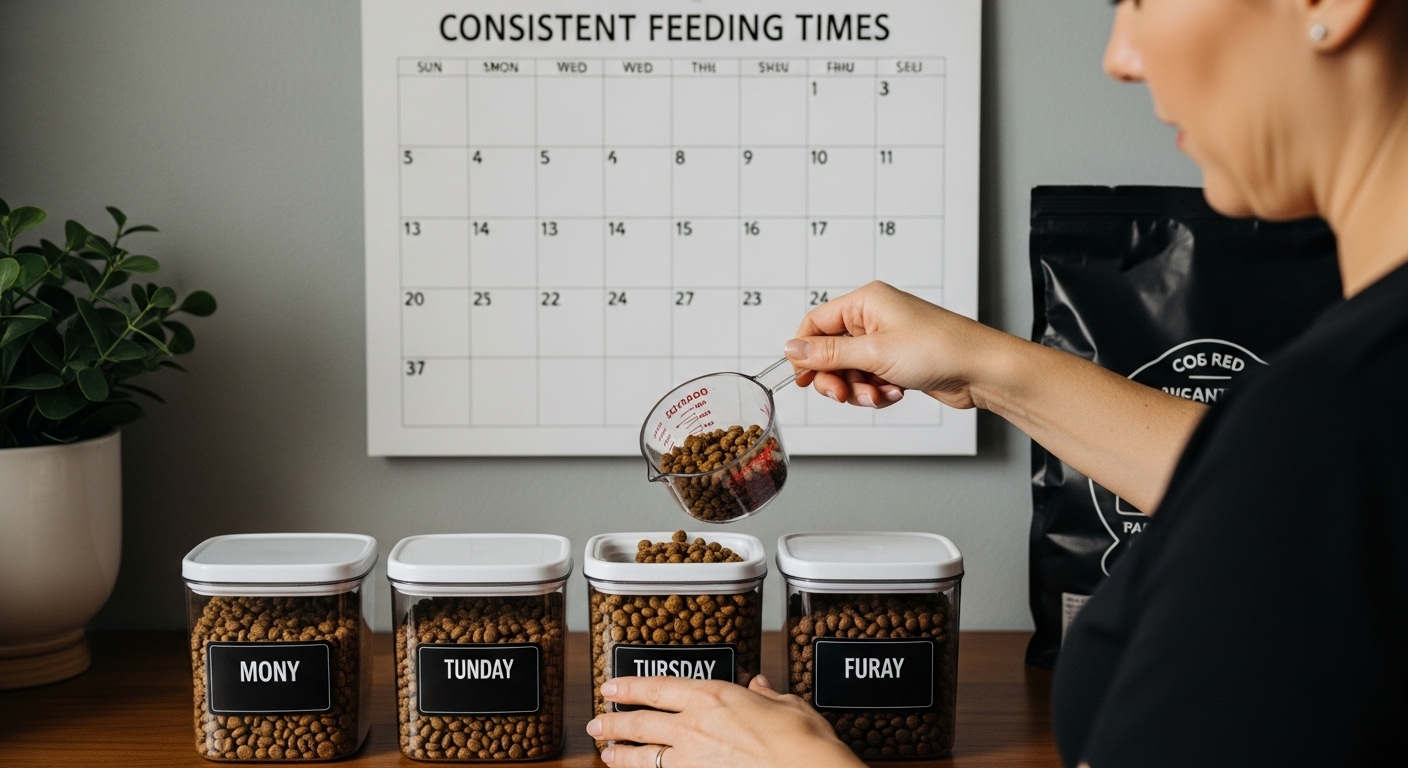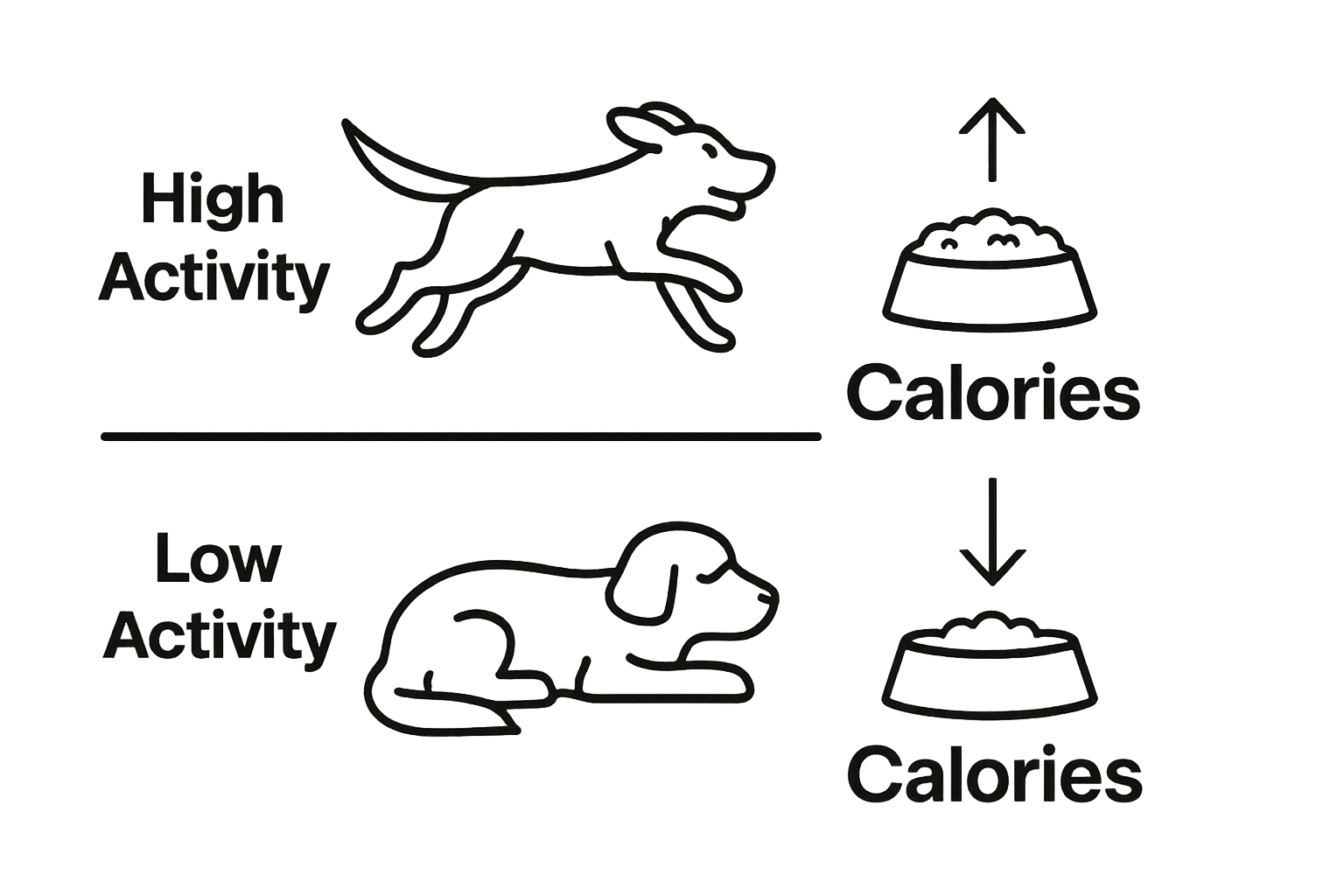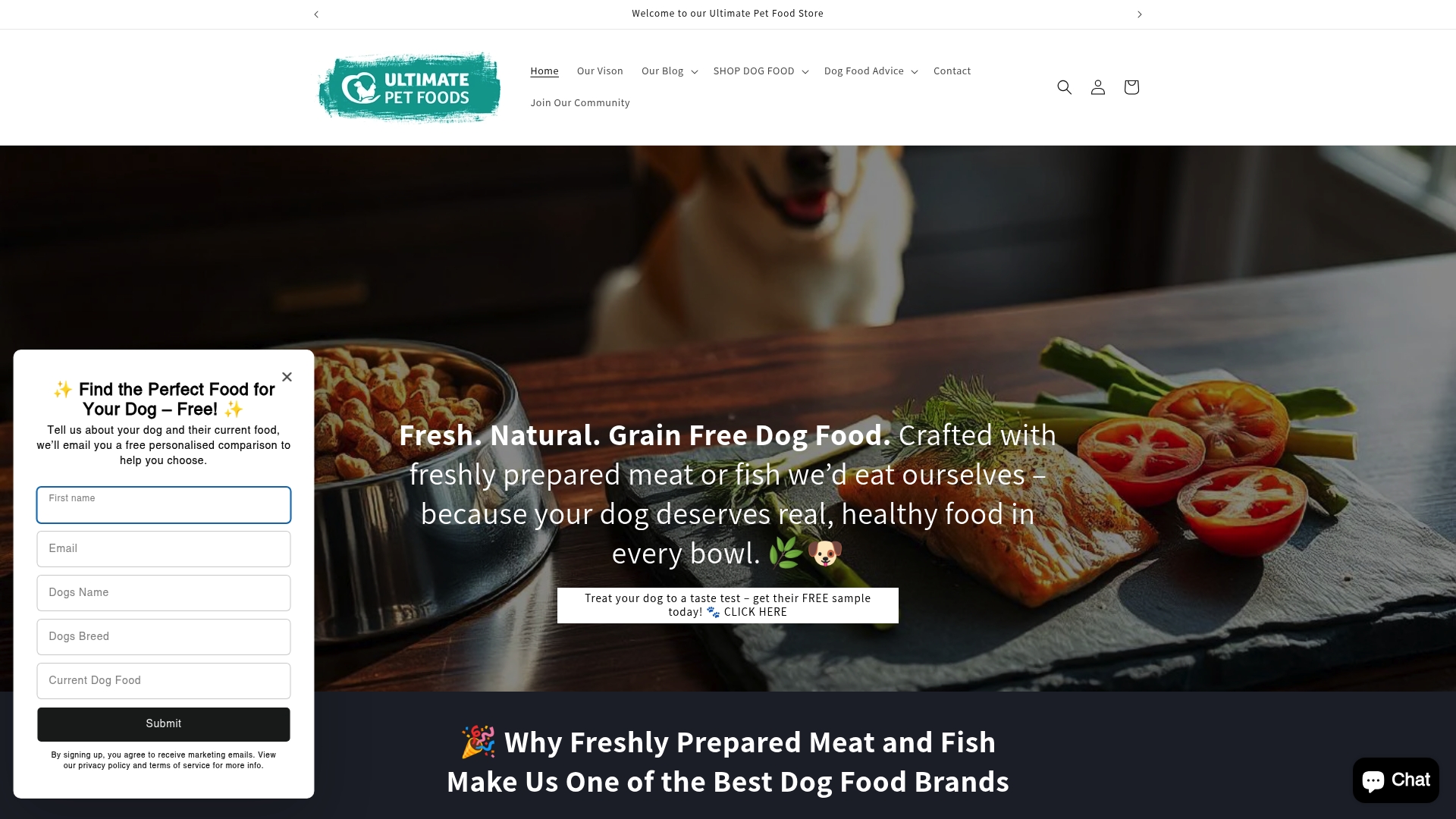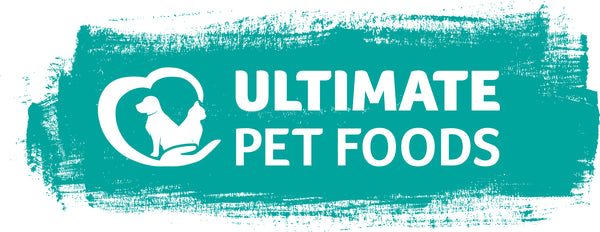
Create the Perfect Dog Feeding Schedule for Optimal Health
Share
Feeding your dog seems straightforward and most pet owners think setting out two meals a day is enough. Yet a border collie running agility can need up to 50 percent more calories than a senior pug lounging at home. So choosing the right feeding schedule actually starts with clues from their lifestyle, not just what’s convenient for you.
Table of Contents
- Step 1: Assess Your Dog’s Dietary Needs
- Step 2: Choose High-Quality, Grain-Free Food
- Step 3: Establish Consistent Feeding Times
- Step 4: Determine Portion Sizes Based On Activity
- Step 5: Monitor Your Dog’s Health And Adjust Accordingly
Quick Summary
| Key Point | Explanation |
|---|---|
| 1. Assess dietary needs individually | Every dog has unique nutritional requirements influenced by age, breed, weight, and health status. |
| 2. Choose high-quality, grain-free food | Prioritise dog foods that list quality proteins first and exclude artificial ingredients for optimal health. |
| 3. Establish consistent feeding times | Routine feeding supports digestion and provides stability for your dog’s well-being and energy levels. |
| 4. Control portion sizes based on activity | Adjust portions according to your dog’s activity level to ensure proper nutrition and weight management. |
| 5. Monitor health and adapt feeding plan | Regularly check your dog’s weight and health indicators to adjust their diet as needed for ongoing wellness. |
Step 1: Assess Your Dog’s Dietary Needs
Creating the perfect dog feeding schedule begins with a comprehensive understanding of your dog’s unique nutritional requirements. Every dog is different, and their dietary needs vary based on multiple critical factors including age, breed, weight, activity level, and overall health status. This initial assessment provides the foundation for developing a tailored nutrition plan that supports your dog’s optimal wellness.
Start by gathering essential information about your dog’s current health profile. Schedule a veterinary consultation to conduct a thorough health evaluation and discuss specific dietary recommendations. Your veterinarian can help identify any underlying health conditions, potential food sensitivities, or breed-specific nutritional requirements that might influence your feeding strategy. During this assessment, key measurements like body condition score, weight, muscle mass, and metabolic rate will help determine precise caloric and nutrient needs.
Age plays a significant role in dietary planning. Puppies, adult dogs, and senior canines have dramatically different nutritional requirements. Young dogs need higher protein and calorie content to support rapid growth, while senior dogs often require lower-calorie diets with enhanced joint support and easily digestible proteins. Activity level is another crucial consideration. Working dogs, athletic breeds, and highly active pets demand more protein and calories compared to sedentary companions. For instance, a border collie participating in agility competitions will have substantially different nutritional needs than a senior pug living in an apartment.
Consider any existing health conditions that might necessitate specialized nutrition. Dogs with allergies, digestive issues, or chronic health problems often require carefully selected diets. Our guide on understanding dog food for sensitive dogs can provide additional insights into managing complex dietary requirements.
Verification checklist for completing this assessment:
- Obtain veterinary health evaluation
- Document current weight and body condition
- Identify specific breed and age-related nutritional needs
- Note any existing health conditions or allergies
- Determine activity level and metabolic requirements
By meticulously assessing these factors, you’ll create a solid foundation for developing a personalized dog feeding schedule that supports your pet’s long-term health and vitality.
Below is a checklist table summarising the key verification steps to complete when assessing your dog’s dietary needs, allowing for a quick, organised review of the assessment process.
| Step | Purpose | How to Complete |
|---|---|---|
| Veterinary health evaluation | Identify nutritional needs and health issues | Schedule veterinary consultation |
| Document weight and condition | Establish baseline for diet planning | Record current weight and body condition score |
| Identify breed & age needs | Tailor diet to life stage and breed-specific requirements | Note breed, age, and related recommendations |
| Note health conditions/allergies | Recognise special dietary considerations | Identify issues during vet visit or observation |
| Determine activity & metabolism | Adjust nutrition to match energy expenditure | Assess daily activity and energy levels |
Step 2: Choose High-Quality, Grain-Free Food
Selecting the right dog food is a critical component of establishing a successful feeding schedule. High-quality, grain-free nutrition provides your dog with essential nutrients while minimizing potential digestive complications and allergic reactions. The goal is to find a premium food that supports your dog’s specific health requirements and meets their unique nutritional profile.
Protein quality should be your primary consideration when evaluating dog food options. Look for products that list freshly prepared meat or fish as the first ingredient, indicating a high-quality protein source. Our freshly prepared kibble is gentle cooked at 82 degrees Celsius to lock in nutrients and preserve the natural goodness of human-grade ingredients. This approach ensures that your dog receives maximum nutritional value with every meal. Prebiotic ingredients like MOS and FOS support digestive health, creating a comprehensive nutritional approach that goes beyond basic sustenance.
When examining potential food options, scrutinize the ingredient list carefully. Avoid artificial preservatives, colours, and unnecessary fillers. Instead, prioritize foods containing whole food ingredients that provide comprehensive nutrition. Natural ingredients offer bioavailable nutrients that support your dog’s overall health more effectively than processed alternatives. Learn more about reading dog food ingredients with our comprehensive guide to make informed nutritional choices.
Consider your dog’s specific life stage and health requirements when selecting a grain-free diet. Puppies, adult dogs, and senior canines have different nutritional needs. Some dogs might require specialized formulas that address specific health concerns such as weight management, joint support, or skin and coat health. Consulting with your veterinarian can help refine your selection and ensure you choose a diet that perfectly matches your dog’s individual requirements.
Verification checklist for selecting high-quality, grain-free food:
- Contains fresh, identifiable meat or fish as primary ingredient
- Free from artificial preservatives and unnecessary fillers
- Matches dog’s specific life stage and health requirements
- Includes beneficial prebiotics for digestive support
- Recommended by veterinary professional
By carefully selecting a high-quality, grain-free food that meets these criteria, you’re laying a strong foundation for your dog’s nutritional wellness and long-term health.
Use the following table as a handy reference checklist to ensure you select a high-quality, grain-free food tailored to your dog’s needs at each mealtime.
| Selection Criterion | What to Look For | Why It Matters |
|---|---|---|
| Fresh meat or fish as primary ingredient | Listed first on the ingredient label | Ensures a high-quality and digestible protein source |
| No artificial preservatives or fillers | Ingredient list free from additives | Reduces risk of digestive upset and allergies |
| Matches dog’s life stage and health needs | Life stage- and health-specific formulas | Provides age/breed-appropriate nutrition |
| Includes digestive prebiotics | Ingredients such as MOS and FOS | Supports gut and digestive health |
| Veterinary recommended | Endorsed by pet healthcare professional | Adds confidence in product quality |
Step 3: Establish Consistent Feeding Times
Developing a consistent feeding schedule is crucial for your dog’s digestive health, metabolic regulation, and overall well-being. Dogs thrive on routine, and a predictable eating pattern helps manage their energy levels, supports digestion, and creates a sense of security. Consistency is key when implementing a feeding schedule that works for both you and your canine companion.
Most adult dogs benefit from two meals per day, typically served in the morning and evening, spaced approximately 8-12 hours apart. Puppies and more active dogs might require three to four smaller meals to maintain steady energy and support their faster metabolisms. The exact timing should align with your household routine, ensuring you can provide meals at similar times each day. Stick to a fixed schedule even on weekends or during holidays to prevent digestive disruptions and maintain your dog’s internal biological rhythm.
Consider your dog’s individual needs when planning feeding times. Working dogs, senior pets, and dogs with specific health conditions might require slight modifications to a standard feeding schedule. Check out our expert tips for successfully transitioning dog foods to help navigate any potential challenges during schedule adjustments. Some dogs might need medication or supplements with their meals, so factor these requirements into your timing strategy.
Creating a feeding routine involves more than just setting clock times. Establish a consistent pre-meal ritual that signals to your dog that food is coming. This might involve a specific location, a particular sound like shaking the food container, or a verbal cue. Such predictable signals help reduce anxiety and excitement around mealtimes, promoting calmer eating behavior. Avoid feeding your dog immediately after intense exercise to prevent potential digestive issues and allow time for proper cooling down.
Verification checklist for establishing consistent feeding times:
- Identify two consistent daily feeding times
- Maintain same feeding schedule every day
- Create a predictable pre-meal routine
- Monitor dog’s energy and digestion
- Adjust times if veterinarian recommends specific modifications
By implementing a structured and reliable feeding schedule, you’ll support your dog’s physical health, mental well-being, and strengthen the bond between you through consistent, nurturing care.
This table provides a concise verification checklist for establishing and maintaining consistent feeding times, streamlining the process for daily routine success.
| Task | Why It’s Important | How to Accomplish |
|---|---|---|
| Identify two daily feeding times | Supports digestion and routine | Choose aligned with household schedule |
| Maintain same schedule daily | Promotes stability and well-being | Feed at similar times each day, including weekends |
| Create predictable pre-meal routine | Reduces anxiety and excitement at mealtimes | Use location, sound, or cue before feeding |
| Monitor energy/digestion | Ensures schedule suits your dog | Observe changes in appetite, mood, digestion |
| Adjust if vet recommends | Supports medical or special needs | Follow veterinarian advice on schedule changes |

Step 4: Determine Portion Sizes Based on Activity
Precise portion control is fundamental to maintaining your dog’s optimal health and preventing nutritional imbalances. Activity level dramatically influences caloric requirements, making it essential to adjust food quantities based on your dog’s daily energy expenditure. A sedentary companion will need significantly fewer calories compared to a highly active working or sporting dog.
Begin by evaluating your dog’s specific activity profile. Breeds like border collies, hunting dogs, and working shepherds require substantially more nutrition compared to lap dogs or senior pets with limited mobility. Consider your dog’s daily exercise routine, including walks, play sessions, training activities, and overall movement patterns. A dog participating in agility competitions or herding work might need up to 50% more calories than a dog who primarily lounges at home.
 Our freshly prepared kibble is designed to provide concentrated nutrition that supports varying energy demands while maintaining optimal protein and nutrient balance.
Our freshly prepared kibble is designed to provide concentrated nutrition that supports varying energy demands while maintaining optimal protein and nutrient balance.
Weight management is another crucial factor in portion control. Use body condition scoring techniques to assess whether your current portions are appropriate. You should be able to feel your dog’s ribs without a thick layer of fat, and they should have a visible waistline when viewed from above. Overfeeding can lead to obesity, which increases risks of joint problems, diabetes, and reduced life expectancy. Our comprehensive guide offers insights into reading dog food ingredients to help you make informed nutritional choices.
Age and metabolism also play significant roles in determining appropriate portion sizes. Puppies, adult dogs, and senior pets have different nutritional requirements. Younger dogs typically need more calories to support growth, while older dogs often require fewer calories but higher-quality protein sources. Monitor your dog’s weight monthly and be prepared to make incremental adjustments to their feeding portions. Consultation with your veterinarian can provide personalized guidance on precise caloric needs.
Verification checklist for determining portion sizes:
- Assess dog’s daily activity level
- Evaluate current body condition
- Monitor weight monthly
- Adjust portions based on energy expenditure
- Consult veterinarian for personalized nutritional advice
By carefully matching food portions to your dog’s activity level, you’ll support their metabolic health, maintain an ideal body weight, and provide the precise nutrition they need to thrive.
Refer to this table as a practical checklist for portion control, making it easier to review the essential steps that ensure your dog receives the right amount of food based on their activity and body condition.
| Step | Action Required | Reason of Importance |
|---|---|---|
| Assess daily activity level | Observe walk, play, and training routines | Determines necessary caloric intake |
| Evaluate current body condition | Check ribs and waistline | Helps identify over- or underfeeding |
| Monitor weight monthly | Weigh and record regularly | Tracks progress and growth |
| Adjust portions as needed | Modify food amount for activity and weight | Supports ideal weight and health |
| Consult veterinarian for advice | Seek tailored feeding guidance | Ensures nutritional accuracy and health monitoring |
Step 5: Monitor Your Dog’s Health and Adjust Accordingly
Developing a perfect dog feeding schedule is an ongoing process that requires consistent observation and thoughtful adaptation. Monitoring your dog’s health is not a one-time task, but a continuous commitment to understanding and responding to their changing nutritional needs. This final step ensures that your carefully crafted feeding strategy remains effective and supportive of your dog’s overall wellness.
Regular health monitoring begins with keen observation of physical and behavioral changes. Weight fluctuations are the most immediate indicator of nutritional effectiveness. Track your dog’s weight monthly, using a consistent scale and recording the measurements. Unexplained weight gain might suggest overfeeding, while sudden weight loss could indicate underlying health issues or insufficient nutrition. Pay attention to your dog’s coat condition, energy levels, digestive regularity, and overall vitality as additional health indicators. These subtle signs provide crucial insights into how well your current feeding schedule meets their nutritional requirements.
Learn more about holistic dog nutrition approaches that can help you develop a more comprehensive understanding of your dog’s health. Quarterly veterinary check-ups are essential for professional assessment. During these visits, discuss your dog’s current diet, review body condition scoring, and seek professional guidance on potential nutritional adjustments. Our freshly prepared kibble, with its human-grade ingredients and carefully balanced nutrient profile, provides an excellent foundation for maintaining optimal health.
Be prepared to make incremental adjustments based on your observations and veterinary recommendations. Factors such as age progression, changes in activity level, emerging health conditions, or seasonal variations can all necessitate dietary modifications. For instance, a senior dog might require lower-calorie options with enhanced joint support, while a recovering dog might need a more protein-rich diet. Transition any dietary changes gradually, introducing new food mixtures over 7-10 days to prevent digestive upset and allow your dog’s system to adapt smoothly.
Verification checklist for monitoring dog’s health:
- Weigh dog monthly
- Observe coat condition and energy levels
- Schedule quarterly veterinary check-ups
- Track digestive health and overall vitality
- Be prepared to make incremental nutritional adjustments
By maintaining a vigilant and responsive approach to your dog’s nutrition, you’ll ensure their feeding schedule remains a dynamic, supportive element of their ongoing health and happiness.
This health monitoring checklist table helps you keep track of ongoing steps for evaluating your dog’s health and adjusting their feeding plan for lifelong wellness.
| Monitoring Task | Frequency | What to Observe/Do |
|---|---|---|
| Weigh dog | Monthly | Record weight trends |
| Observe coat and energy | Ongoing | Notice changes in shine, thickness, behaviour |
| Schedule veterinary check-ups | Quarterly | Discuss diet, weight, and body condition |
| Track digestive health/vitality | Ongoing | Note stool, appetite, activity |
| Make nutritional adjustments as required | As needed | Adapt portions or food based on findings |
Ready to Create a Tailored Feeding Routine for Your Dog?
You have just learned how vital it is to personalise your dog’s feeding schedule by considering their breed, age, and activity level. The biggest challenge for many owners is finding a diet that truly matches these unique needs. Whether you are struggling with portion sizes, worrying about sensitive digestion, or aiming to optimise your dog’s long-term health, choosing high-quality nutrition is essential. Discover our specialised range of grain free small breed dog food or explore Nutritious & Delicious large breed puppy food if you have a growing companion.

Now is the perfect moment to put your new knowledge into practice. Choose a complete and balanced diet packed with human-grade ingredients from Ultimate Pet Foods and set your dog on the path to thriving health. Shop online today and start building the perfect feeding schedule that suits your dog’s every need.
Frequently Asked Questions
What should I consider when assessing my dog’s dietary needs?
Begin by evaluating your dog’s age, breed, weight, activity level, and overall health status. A veterinary consultation can help identify specific dietary requirements and any underlying health conditions that may affect nutrition.
How can I choose a high-quality dog food?
Look for dog food that lists fresh meat or fish as the first ingredient, avoids artificial preservatives and fillers, and includes beneficial prebiotics for digestive health. Always ensure the food matches your dog’s specific life stage and health requirements.
How often should I feed my dog?
Most adult dogs benefit from two meals a day, while puppies and highly active dogs may require three to four smaller meals. Consistency in feeding times is essential to support your dog’s digestive health and overall well-being.
How do I determine the right portion sizes for my dog?
Evaluate your dog’s daily activity level and monitor their body condition. Adjust portions based on energy expenditure, which varies between active and sedentary dogs. Consulting with your veterinarian can provide tailored advice on portion sizes.
Recommended
- Understanding Holistic Dog Nutrition for Healthier Pets – Ultimate Pet Foods
- Expert Tips for Transitioning Dog Foods Successfully – Ultimate Pet Foods
- Understanding Dog Foods to Avoid for Optimal Health – Ultimate Pet Foods
- What Ingredients to Avoid in Dog Food for Healthier Pups – Ultimate Pet Foods
